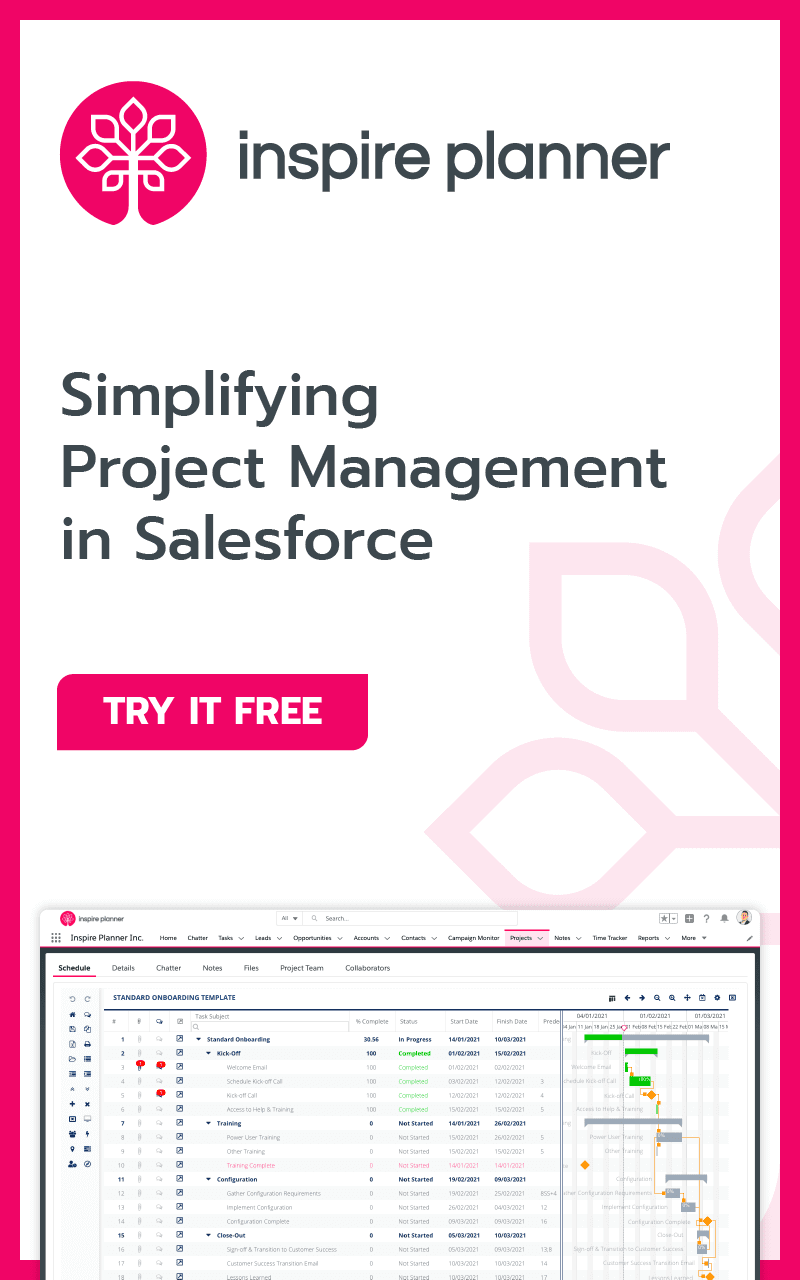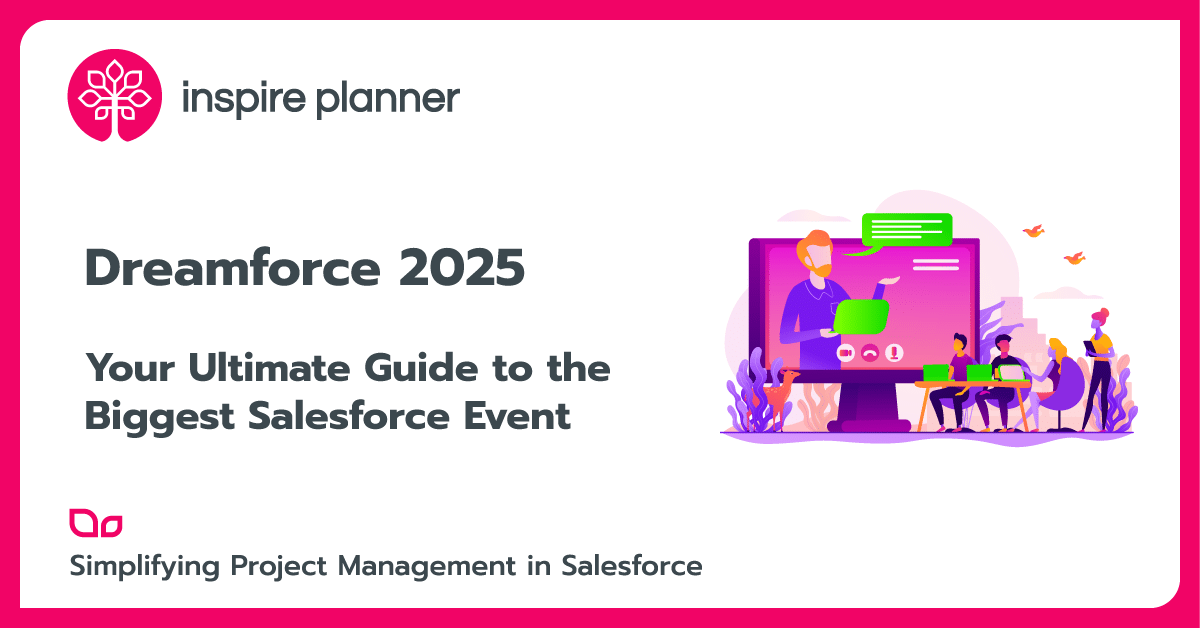Essential Salesforce Project Management Skills Every Admin Should Master
Project ManagementSalesforce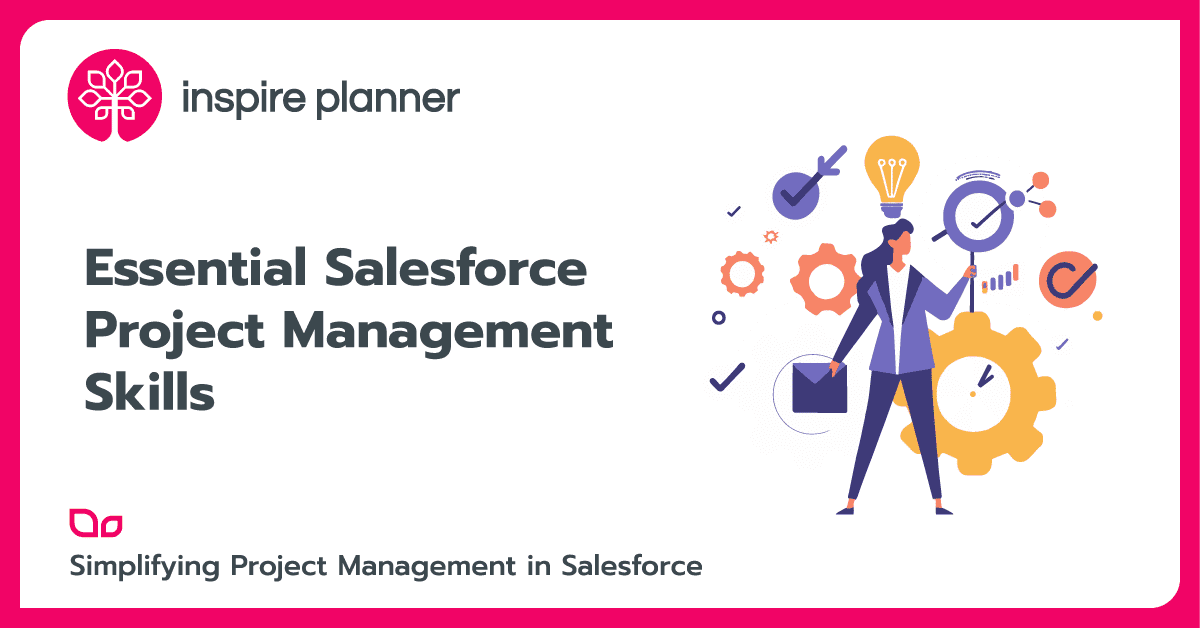
Have you ever wondered why some Salesforce projects soar while others stumble? It often comes down to Salesforce project management skills. A recent study by the Project Management Institute revealed that organizations that implement project management best practices experience a 2.5 times higher success rate.
As businesses increasingly rely on Salesforce to manage customer relationships, sales processes, and operational workflows, the scope and complexity of projects continue to expand. To lead these projects to success, Admins must possess a deep understanding of the platform and master essential Salesforce project management skills.
Project managers are leaders who provide crucial guidance on who, what, when, and how implementations will proceed, granting them significant influence within a company. For instance, if a project manager determines that a deadline must be adjusted to accommodate a new development, the deadline is revised accordingly. Developing Salesforce project management skills can enhance an admin’s confidence in their place at the decision-making table, potentially leading to promotions and career growth.
Moreover, Salesforce project management skills are highly transferable. Admins can apply these skills in various contexts, such as organizing a fundraising event for a local nonprofit. Including these volunteer experiences on a resume can effectively highlight the Salesforce project management skills, even if they are not directly related to Salesforce.
Essential Salesforce Project Management Skills for Admins
In this article, we have decided to organize the essential skills into two major groups: soft skills and hard skills.
Salesforce Project Management Skills: Soft Skills for Project Success

Effective Communication and Collaboration
Effective communication is one of the key Salesforce project management skills. In fact, poor communication is the main reason projects fail in one out of three cases, and it negatively affects project outcomes in over 50% of instances.
Here are some tips you can follow to improve communication and collaboration in your projects:
- Implement a communication plan that outlines how and when information will be shared. For example, schedule weekly status updates, bi-weekly stakeholder meetings, and daily team stand-ups.
- Leverage Salesforce Chatter to create dedicated project channels for real-time discussions and updates. Use @mentions to ensure critical information reaches the right people. Some of the Salesforce native project management tools, such as Inspire Planner, can automatically create project-specific and task-specific Chatter feeds for you.
- Utilize Salesforce’s permission sets to control access to sensitive project information, ensuring stakeholders only see what’s relevant to their roles.
- Implement a RACI (Responsible, Accountable, Consulted, Informed) matrix within Salesforce to clarify roles and responsibilities for each project task.
Leadership and Mentorship
- Leadership in the Salesforce environment is not just about managing tasks; it’s about fostering a culture of trust and collaboration that drives project success.
- Conduct regular one-on-one meetings with team members to understand their perspectives and challenges. Use Salesforce Analytics to track team sentiment and productivity trends.
- Implement a mentorship program within your Salesforce projects, pairing experienced team members with newcomers to foster knowledge sharing and personal growth.
- Use tools like Salesforce Quip to create collaborative documents for the project vision and goals. This will allow team members to contribute ideas and feel more invested in the project’s success.
Adaptability and Flexibility
- The dynamic nature of technology projects, particularly within Salesforce, often requires rapid adaptation to changing scopes and requirements. Adaptable and flexible admins can better navigate these changes, ensuring projects stay on track. This adaptability is especially critical in Agile environments, where iterative progress and frequent adjustments are the norms.
- Implement change management processes within Salesforce. Use custom objects to track change requests, their impacts, and approvals.
- Utilize Salesforce’s release readiness feature to stay ahead of platform updates and assess their impact on your project.
- Conduct regular “what-if” scenario planning sessions with your team to model different project outcomes based on potential changes.
Tip: Create a custom Salesforce dashboard that tracks project flexibility metrics, such as the number of successfully implemented changes, adaptation time, and impact on project timeline and budget.
Conflict Resolution
Disagreements and conflicts are inevitable in any project. According to our survey results, the typical worker dedicates 2.1 hours per week to addressing various forms of conflict. This amounts to roughly one full workday each month spent on conflict-related issues. Techniques such as active listening, mediation, and using Salesforce’s collaborative tools can help resolve disputes before they escalate.
Strategies to deal with conflicts:
- Implement a conflict resolution workflow in Salesforce, using custom objects to track issues, their root causes, and resolution steps.
- Utilize Salesforce Surveys to regularly gather anonymous feedback from team members, helping to identify and address potential conflicts early.
- Leverage Salesforce Einstein Analytics to analyze patterns in project delays or issues, potentially uncovering underlying conflicts that need addressing.
Decision Making
- Salesforce Admins are often required to make quick, data-driven decisions. The ability to interpret Salesforce data and insights effectively can significantly impact project outcomes.
- Leverage Salesforce project management tools‘ reporting and dashboard capabilities to gain real-time insights into key metrics such as task completion rates, resource utilization, and budget variance.
- Implement Salesforce Einstein Analytics to leverage AI-driven insights, helping you identify trends and make predictive decisions about project outcomes.
- Use Salesforce’s external data integration capabilities to incorporate data from other solutions outside project management, providing a more comprehensive view of project health.
Salesforce Project Management Skills: Hard Skills for Technical Proficiency
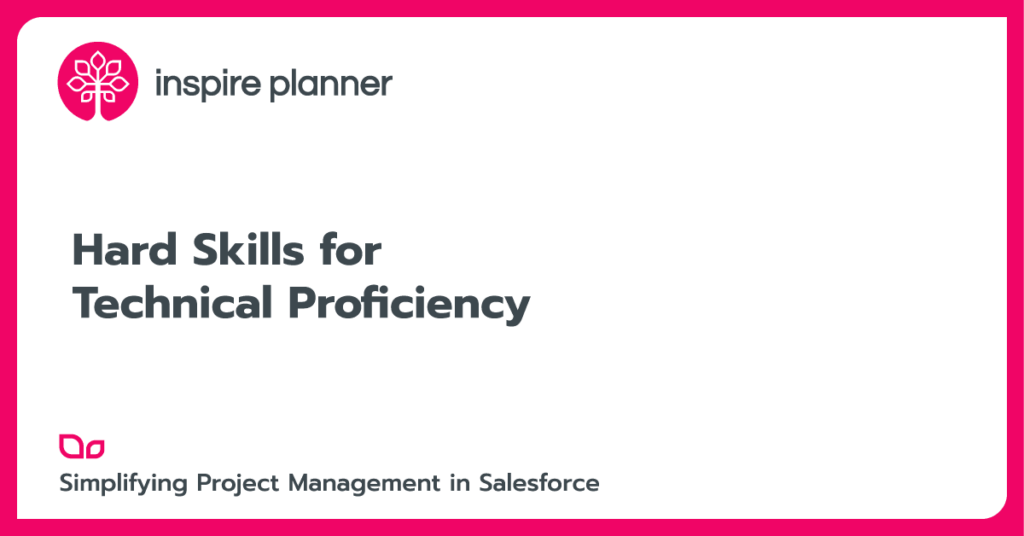
Time and Resource Management
- Managing timelines and resources efficiently is among the most critical Salesforce project management skills for the success of any project. Luckily, Salesforce native tools like Inspire Planner offer such functionality out of the box.
- Implement resource leveling techniques. This helps optimize resource allocation and prevent overallocation.
- Utilize Inspire Planner’s Gantt chart functionality to visualize project timelines, dependencies, and critical paths.
- Implement Agile time-boxing techniques within Salesforce, using tools like Inspire Planner to track backlog, sprints, user stories, and burndown rates.
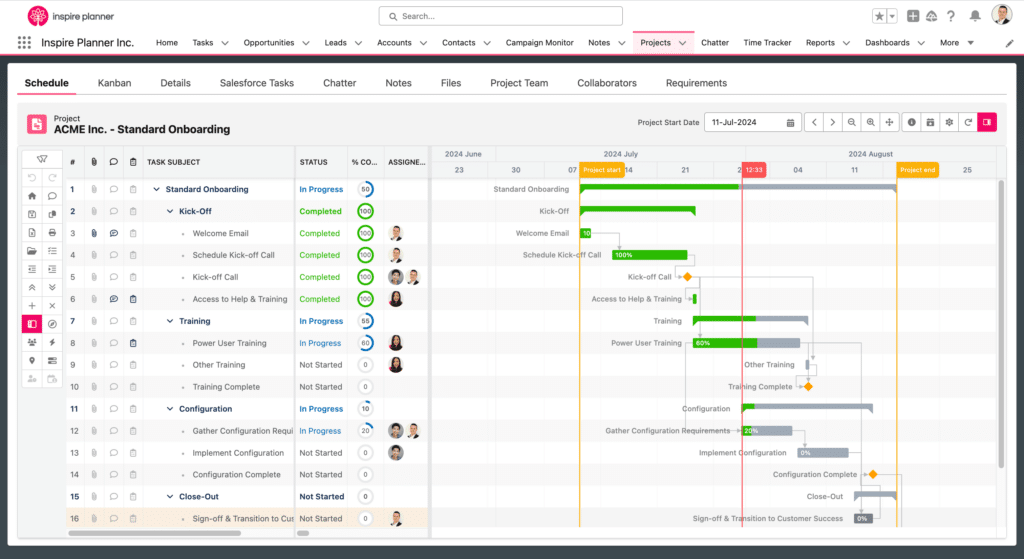
Risk Management and Quality Assurance
- Utilize a risk register within Salesforce, using custom objects or ready solutions like Inspire Planner to track potential risks, their likelihood, impact, and mitigation strategies.
- Implement automated testing scripts using Salesforce DX to ensure consistent quality across your implementations.
- Utilize Salesforce Shield for enhanced security and compliance monitoring, which is crucial for sensitive data projects.

Technical Proficiency with Salesforce Tools
- A deep understanding of Salesforce’s functionalities is essential for effective project management. Admins should be proficient in using Salesforce’s reporting, dashboards, and automation tools to manage and monitor project progress. Continuous learning and staying updated with the latest Salesforce releases can ensure that Admins leverage the platform to its full potential.
- Master Salesforce Flows to create complex, automated business processes that streamline project workflows.
- Leverage Salesforce CPQ to manage complex pricing and quote aspects of your projects, ensuring accurate budgeting and resource allocation.
- Utilize Salesforce’s Lightning Web Components to create custom, reusable UI elements for your project management needs.
Commit to continuous learning by setting aside weekly time to explore new Salesforce features and complete Trailhead modules relevant to your current projects.
Data Analysis and Interpretation
Salesforce’s Analytics Cloud and other business intelligence tools can provide valuable insights into project performance, helping Admins identify trends, forecast issues, and make data-driven decisions.
Advanced Techniques:
- Implement Salesforce Einstein Discovery to uncover hidden patterns in your project data and receive AI-powered predictions and recommendations.
- Use Salesforce’s Data Loader to perform mass updates and cleansing, ensuring your project data remains accurate and actionable.
- Create custom Salesforce report types that combine data from multiple objects to gain deeper insights into project performance. Check out our detailed guide about Salesforce reports for project management if you want to learn more about this topic.
Project Budgeting and Cost Management
- Managing budgets effectively is crucial to ensuring that Salesforce projects are financially viable. Salesforce Admins should be adept at using budgeting tools within the platform to track expenses, forecast costs, and ensure projects remain within budget. Understanding cost-benefit analysis and return on investment (ROI) within the Salesforce context can also enhance financial decision-making.
- Explore existing Salesforce project management tools like Inspire Planner that offer built-in budgeting and cost management features.
- If you prefer to build something from scratch, implement a custom Salesforce feature for budget tracking that integrates with your project tasks and timelines, providing real-time cost monitoring.
- Utilize Salesforce’s forecasting features to project future costs based on current spending patterns and project progress.
- Create dashboards that visualize budget allocation, actual spending, and variance across different project phases and categories.
Leveraging Project Management Methodologies in Salesforce
Successfully managing Salesforce projects often requires a blend of different project management methodologies. Understanding these methodologies and knowing when to apply them can significantly impact project success.
Here’s how Salesforce Admins can leverage various methods:
Agile Methodology
Agile emphasizes flexibility and continuous improvement, making it ideal for Salesforce projects where requirements may evolve. The methodology’s iterative nature allows for the regular review and adjustment of project goals, aligning them with business needs.
Advanced Agile Techniques:
- Implement the Plan-Do-Check-Act (PDCA) cycle within Salesforce projects to ensure continuous improvement. Use Salesforce’s task management features to break down tasks into smaller, manageable pieces and to iterate on them in short cycles.
- Leverage Kanban boards within Salesforce to visualize workflow, track progress, and manage workloads effectively.
- Utilize User Stories in Salesforce to capture requirements from the end-user’s perspective.
Scrum Framework
Scrum, a subset of Agile, provides a structured yet flexible approach to managing complex projects. Understanding the specific roles within Scrum—such as the Product Owner, Scrum Master, and Development Team—enables Admins to organize their teams effectively.
Advanced Scrum Techniques:
- Sprint Retrospectives: Implement regular retrospectives at the end of each sprint within Salesforce to reflect on what went well, what didn’t, and what could be improved.
- Backlog Refinement: Regularly refine the product backlog within Salesforce to ensure it remains relevant and prioritized according to current project needs. Use custom fields and filters to manage and prioritize backlog items efficiently.
- Sprint Planning Meetings: Conduct detailed sprint planning meetings using Inspire Planner Agile Projects or Salesforce’s collaboration tools, ensuring each team member understands their tasks and deadlines. Manage task assignments based on the outcome of these meetings.

Waterfall Methodology
The Waterfall methodology is well-suited for projects with clearly defined requirements and a linear path to completion. Admins can use Waterfall’s structured approach to manage Salesforce projects with fixed scopes, ensuring each phase is completed before moving to the next.
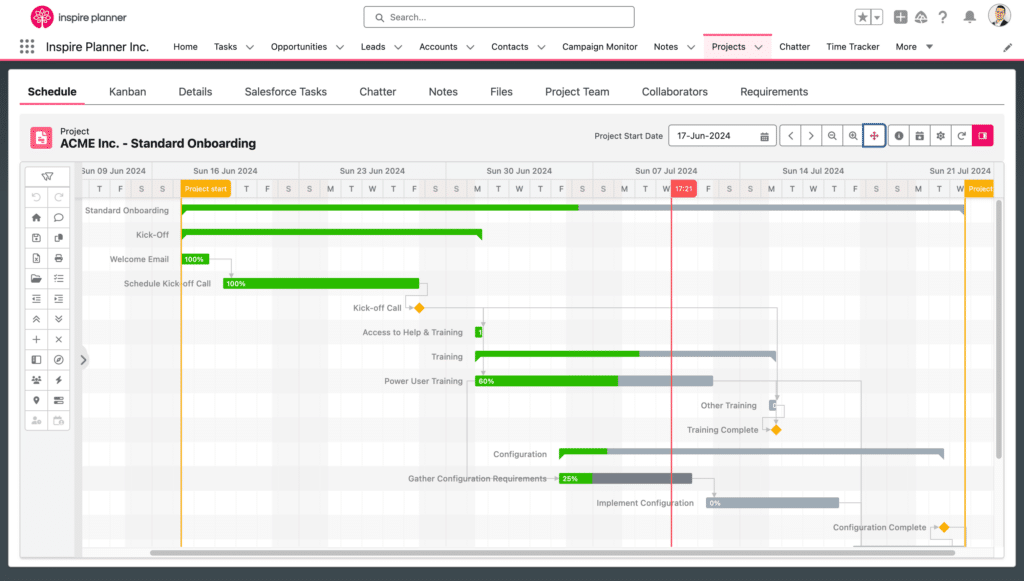
Advanced Waterfall Techniques:
- Detailed Requirement Gathering: Use Salesforce’s custom objects to create comprehensive requirement documents outlining every project aspect before implementation begins. This ensures that all stakeholders are aligned and reduces the risk of scope creep.
- Phase Gate Reviews: Implement phase gate reviews within Salesforce to ensure each project phase is fully completed and meets all requirements before moving on to the next phase. Use Salesforce’s approval processes to formalize these reviews and document their outcomes.
- Critical Path Analysis: Use Inspire Planner’s Gantt chart and task management tools to perform critical path analysis, identifying the most crucial tasks that must be completed on time for the project to stay on track.
Hybrid Approach
A hybrid approach combines Agile, Scrum, and Waterfall elements, allowing Admins to tailor their project management methodology to the project’s specific needs. Salesforce deployments particularly benefit from this flexibility, as they require meticulous preparation alongside the capacity to respond to evolving conditions.
Advanced Hybrid Techniques:
- Custom Workflow Development: Develop custom workflows within Salesforce that incorporate elements of Agile, Scrum, and Waterfall methodologies. For example, Agile can be used for iterative development, and Waterfall can be used for initial planning and documentation.
- Scalable Project Management: Use Salesforce’s customization features to scale your hybrid methodology according to the size and complexity of the project. For larger projects, incorporate more rigorous documentation and planning, while smaller projects may benefit from a more flexible, iterative approach.
- Integrated Project Dashboards: Create integrated project dashboards in Salesforce that combine metrics from both Agile and Waterfall approaches, providing a comprehensive view of the project’s progress and health.
Waterfall vs. Agile Project Management
| Waterfall Approach | Agile Approach |
| Clearly defined requirements | Requirements evolve progressively |
| Detailed upfront planning | Continuous planning and execution |
| Single-phase delivery | Delivery in incremental stages |
| Stakeholders involved at key points | Stakeholders involved throughout the process |
| Time and cost set during planning | Time and cost adjusted as the project progresses |
| Risks identified early | Risks continually assessed and managed |
| Changes tightly controlled | Changes anticipated and integrated frequently |
Best Practices for Salesforce Project Management
Defining Project Scope and Objectives
The project scope outlines all the work required to achieve the desired outcome or result. The project scope statement specifies what is and is not included in the project. For the workspace reconfiguration project, the project manager must ensure that exactly 30 workspaces are reconfigured—no more, no less. Any additional work would be considered out of scope.
Best Practices:
- Define Project Scope: Clearly outline all the work required to achieve the expected outcome based on stakeholders’ requirements. Ensure everyone knows what is included and excluded from the project.
- Avoid Scope Creep: Prevent unauthorized changes by managing stakeholder expectations and using visual tools, such as a “scope box,” to clarify what’s in and out of scope.
- Collaborative Scope Planning: Engage the project team and stakeholders in a detailed discussion to reach a consensus on the project requirements and avoid misunderstandings.
- Manage Triple Constraints: Balance scope, schedule, and cost to deliver the project on time and within budget. Adjust one constraint carefully to avoid negatively impacting the others.
Tip: Create a custom Lightning component that visualizes the project’s scope and objectives and the organization’s broader strategic goals, helping to maintain alignment and demonstrate value.
Creating a Comprehensive Project Plan
A detailed project plan is essential for guiding the project from start to finish.
Best Practices:
- Define Scope with WBS: Outline all project work using stakeholder requirements and develop a Work Breakdown Structure (WBS) that lists all activities, sub-deliverables, and the final deliverable.
- Estimate Activity Durations: Assign qualified team members to tasks and estimate time for each activity using a Gantt chart, considering task dependencies and ensuring the project stays on track.
- Calculate Costs: Determine costs by breaking down component purchases (e.g., software, hardware) and labor rates, adjusting estimates based on new data from RFQs or other sources.
- Communicate and Manage Risks: Identify and communicate potential risks, such as scope changes or cost overruns, to stakeholders and prepare contingency plans to mitigate these risks before project execution.
Tracking Key Performance Indicators (KPIs)
Measuring project success requires careful tracking of KPIs.
Advanced KPI Tracking in Salesforce:
- Develop a custom Salesforce dashboard that displays real-time project KPIs, including budget variance, schedule performance index (SPI), and stakeholder satisfaction scores.
- Utilize Salesforce Einstein Analytics to perform predictive analysis on your KPIs, forecasting potential issues before they occur. For example, Einstein can analyze past project data to forecast budget overruns or timeline delays, allowing project managers to take corrective actions before issues become critical.
- Implement automated alerts and notifications when KPIs deviate from expected ranges, allowing for proactive management.
Tip: Create a KPI scorecard within Salesforce that weights different metrics based on their importance to project success, providing a comprehensive measure of project health.
Manage Risks
Risk is an inherent part of any project, influencing decisions and outcomes. Understanding your risk attitude is crucial whether you’re a natural risk-taker, a cautious planner, or somewhere in between. Risk attitude is shaped by appetite, tolerance, and threshold. These factors guide how much uncertainty you will accept in pursuing project goals.
Best Practices for Effective Risk Management:
- Identify and Categorize Risks: Identify potential risks using tools like a risk register. Organize risks into strategic, operational, technical, and compliance categories to ensure comprehensive coverage.
- Involve Stakeholders: Engage key stakeholders, sponsors, and subject matter experts in risk identification and ownership. Their insights are critical for accurately assessing and managing risks throughout the project.
- Analyze Risks Qualitatively: Assess each identified risk by its probability of occurrence and potential impact using a simple scale. This helps prioritize risks and determine overall project exposure.
- Mitigate and Monitor: Develop strategies to mitigate high-priority risks and continually monitor them throughout the project lifecycle. Risk management is an ongoing process that requires constant attention to prevent negative impacts on the project and organization.
Engaging Stakeholders and End-Users
Active engagement with stakeholders and end-users is critical for ensuring project success.
Best Practices:
- Implement a stakeholder management strategy within Salesforce, using custom objects to track stakeholder information, communication preferences, and engagement levels.
- Utilize Salesforce Communities to create a dedicated space for stakeholder collaboration and feedback.
- Leverage Salesforce’s Journey Builder to create personalized stakeholder engagement journeys, ensuring timely and relevant communication throughout the project lifecycle.
Real-World Applications: Salesforce Project Management Skills in Action
Let’s consider a real-world example to illustrate the importance of these Salesforce project management skills. Imagine a Salesforce implementation project for a mid-sized company looking to automate its sales processes. By effectively managing communication, adapting to changing requirements, and leveraging Salesforce tools, the Salesforce Admin can successfully lead the project to completion, resulting in a 30% increase in sales productivity.
Mastering these Salesforce project management skills is essential for Admins who consistently want to deliver successful projects. The expanding Salesforce landscape will increase the need for proficient project managers specializing in this domain. Admins who invest in developing these skills will be well-positioned to lead their organizations to success.
For those looking to enhance their Salesforce project management skills further, consider enrolling in the Salesforce Admin 201 certification course offered by saasguru. This course provides a comprehensive foundation in Salesforce, equipping you with the knowledge and skills necessary to excel as a Salesforce Admin.

